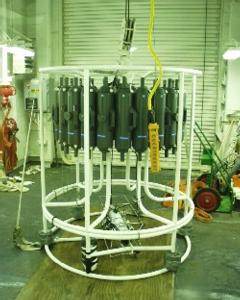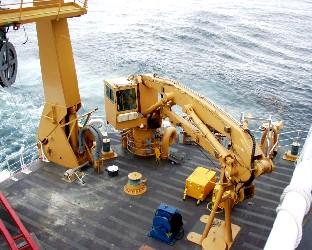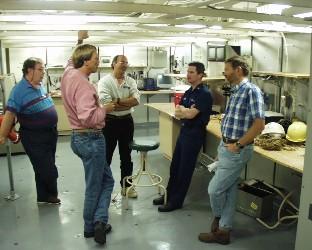17 June, 2000
17 June 2000
Not Your Typical Research Cruise
While we are in Nuuk changing out science personnel, I should take the
opportunity to describe for you how this cruise differs from a “typical”
scientific research cruise. First of all, when most people hear cruise they
think of the “Love Boat” or cruising around warm tropical waters, sipping
exotic drinks, and trying to decide whether to go for a swim, play
shuffleboard, gorge at the banquet table, or dance the night away in the
disco. Scientific cruises resemble that type of cruise only in the fact
that they take place on a boat out at sea.
Research cruises take place on board research vessels, which are essentially
floating scientific laboratories designed to collect scientific data from
the ocean. These mobile research tools are very expensive to both build and
operate. For example, the HEALY cost $220 million to build, and most ships
cost $20,000 per day to operate. Due to these costs, it is imperative that
those using research ships get the most for their money. In most research
cruises, there will be several researchers collecting several types of data.
Scientists write proposals to do parcticular research projects and then
projects and ship schedules are combined to develop research cruises. Data
is often collected along a designated track known as a transect. Such data
allows researchers to shown patterns in an area and differences from site to
site. Each site where data is collected along a transect (or any point
where a ship collects data) is known as a station, and many different people
may be collecting many types of data at any given station. Long cruises of
one to two months may have as many as 100 or more stations. There really is
no such thing as a “typical” research cruise, because there are so many
types of data that may be collected and so many ways to do it. There could
be plankton collection or water column sampling similar to what was tested
on the USCGC Healy on Legs 1 and 2, or mooring similar to what we tested on
Leg 3 or coring which we will test on Leg 4. There may be trawls to collect
material from the bottom, or nets may be used to collect organisms swimming
in the water. There is really an incredible variety of ways a research
cruise could be organized.
So what makes our cruise such an atypical one? This is a test cruise.
USCGC Healy is a brand new vessel, and before it is used for the more
typical cruise, the Coast Guard and the scientific community want to be sure
it can actually do all the things that it may be called upon to do in the
future. So, instead of taking out a large group of scientists and doing
lots of different data collection, this cruise is focusing on one or two
pieces of equipment and types of data collection during each of the
scientific testing legs. This results in frequent changes of personnel, so
that researcher’s valuable time isn’t used waiting for their turn to test
the equipment that is their area of expertise. That is why John Kemp and
Jeff Lord of Wood’s Hole and Rich Findley of University of Miami are on
their way to other jobs and a new set of researchers is in the process of
boarding the ship. You will meet them in the days to come. Stay tuned for
more testing.

The CTD in its storage area. See Susan's and Janice's journals for CTD info.

MST2 El McFadden at work in the electronics/computer lab.

One of the cranes used to move scientific equipment around the deck.

Planning for the coring mission in the main science lab.

The A-frame which is used to lower heavy equipment over the stern of the ship.
Contact the TEA in the field at
.
If you cannot connect through your browser, copy the
TEA's e-mail address in the "To:" line of
your favorite e-mail package.
|
